To honour Papatūānuku and our environment, the tamariki of Ōpoutere kura undertook a whole school planting project in the school ngahere (forest). With funding from One Billion Trees through Toimata Foundation we were able to purchase 500 native trees to restore our ngahere which was damaged in early 2023 due to cyclones Hale and Gabrielle. The ngahere is the favourite play area for our Ōpoutere tamariki so this quickly became a child-led project. Our enviro-group took over the planning and implementing of our planting day.
When asked how they felt when we couldn’t enter the ngahere due to tree fall, the tamariki stated:
“Bad coz I really like to play in there because I love nature and worried because if the trees all fall down, we can’t breathe.” – Leo, 6yrs and “Really nervous and sad. I was nervous because I thought all the trees might fall down and sad because I love nature. I’m happy again now because we can play in there again and climb the big old trees still there.” – Dakota, 7yrs
Where have we come from?
Our ngahere started being established in 1952 with the planting of two Kauri trees in amongst the native and not so native bush. The area was under-utilised for years until our now principal (Jethro Dyer) initiated the Ōpoutere Enviroschools journey in 2009. Jethro wanted to explore ways to connect tamariki to te taiao more naturally and easily within the school grounds.
With a huge community effort, the ngahere was cleaned up and a lot of pest plants and rubbish were cleared out. Members of the community built our first shade houses to protect and raise seedlings – the start of our growing and nurturing of both people and nature!
It is a happy coincidence that our core beliefs are closely aligned to the Enviroschools kaupapa and guiding principles, which makes it easy to weave both into the Action Learning Cycle process as we undertake learning inquiries and make environmental changes to our kura. This integration of Enviroschools has led to deep connections with te taiao for teachers and students alike. Everything is seen through an Enviroschools lens and the tamariki have an intuitive connection to this whenua and the natural affinity and care of this place by all is what led to our ngahere regeneration this year.
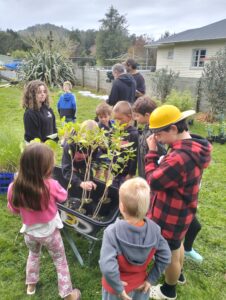
The quality control team checking things before planting.
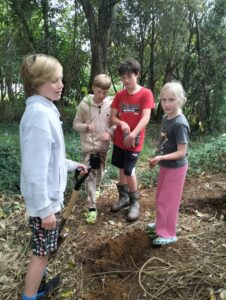
Learning about good planting techniques.
Regenerating our ngahere
The enviro-group, consisting of a full range of ages from the school undertook soil testing, tree identification, measuring and calculating to figure out how many trees and what species were needed for our regeneration project. They then consulted the maramataka (Māori lunar calendar) to find a suitable planting day, June is considered an excellent time for planting and that coincided with World Environment Day on 5 June.
Our whole school community were invited to participate, and we started taking action for this year’s wave of regenerative planting.
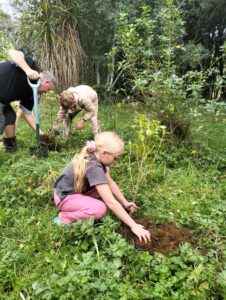
Working together to regenerate the ngahere – Pittosporum and Coprosma species added to the diversity.
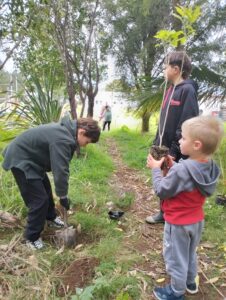
Spacing out the plants along the pathway.
It takes a village
As always, we couldn’t have carried out this day without help from our wonderful community so we would like to give a huge shout-out to them all. Warren at Waihi native plants shared his expertise and time in selecting plants and their delivery. The amazing crew at Bunnings, especially Amber and Katrina, organised extra funding and came out to do a bang-up job (literally) of building us two lovely planter boxes. Thanks to Barney O’neill from O’neill engineering for his hole digging expertise and supply of fruit to sustain us. Joelene Buchan, our Enviroschools facilitator, has supported us from start to finish on this project. Craft Haus Whangamatā supplied the sausage sizzle goodies, and the awesome Onemana fire brigade turned up to help cook and feed our hungry tamariki (after everyone had worked up an appetite!). And last but not least, we really appreciate our wonderful whānau who continue to show up and support us on our planting haerenga (journey). Your commitment to your tamariki and their learning is next level!
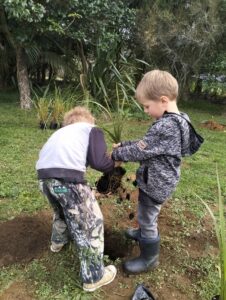
Teamwork.
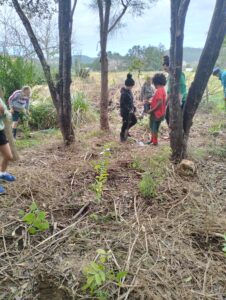
Newly planted and more mature – titoki and kawakawa are part of mix of species chosen.
Keeping our native restoration sustainable.
When asked what they had noticed about the ngahere since we did the new planting (and why) Rahsaan 6 yrs replied:
“We need to look after the little trees more because some are dying…from peoples feet running over them, the jasmine weed, too much wind and the pukekos!”.” – Rahsaan 6yrs
We have calculated that the planting of this many trees will take approximately 30 tonnes of carbon from the atmosphere and of course increases the local biodiversity.
The year 6/7 children are now conducting an inquiry into pest control to manage weeds and animals that are (based on our observations), killing some of our saplings and even some older trees.
The enviro-group are keen to make a book to inform future students of our process and a “how to” guide.
We enlisted the Kauri Protection programme to come to school to teach us how to care for our kauri on school grounds and this has sparked huge interest on how to care for and protect our kauri the children have already stated the following.
“We need to make a path of wood through the ngahere so we can walk on it and not kill our kauri trees” Bonnie 6yrs and “We should build a boot scrubber!” Adelaide 7 yrs commented after learning about kauri tree die back.
The project and planting day was a huge success with our ngahere now set to be restored to its former glory in the next 10 to 20 years and with the addition of a Pa Harakeke (a natural flax playground). It also ensures that all future generations of children who come through our doors will be able to continue creating connections with te taiao (the environment) and you couldn’t really ask for more than that!
Natalie Keogh – Enviroschools lead teacher Ōpoutere School